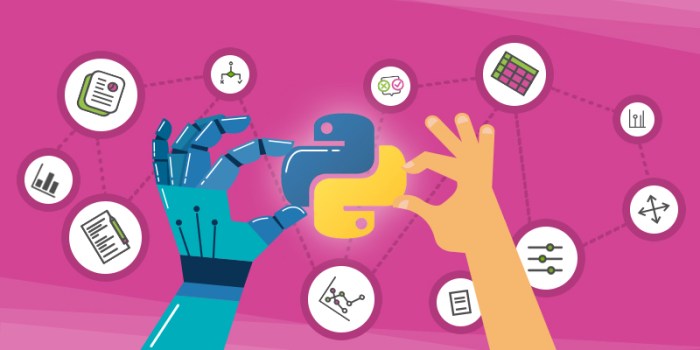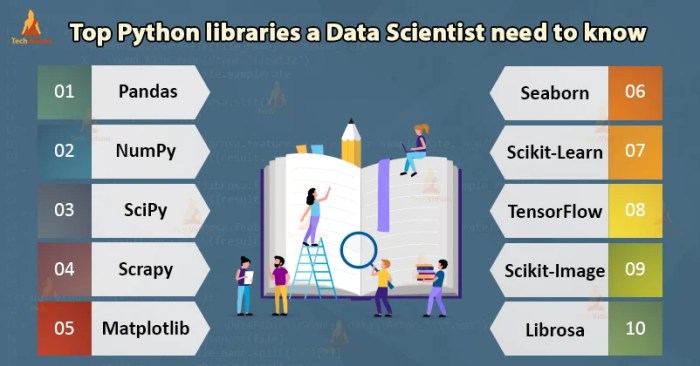Step into the realm of Python programming for data science, where the magic of data manipulation and analysis unfolds in a captivating journey filled with real-world applications and innovative solutions. Get ready to dive deep into the world of data with Python as your ultimate tool!
Let’s explore how Python plays a crucial role in unraveling the mysteries hidden within vast datasets and creating impactful insights that drive decision-making in various industries.
Python Programming for Data Science

Python has become one of the most popular programming languages in the field of data science due to its versatility, ease of use, and a wide range of libraries specifically designed for data analysis and manipulation.Python is extensively used for data manipulation and analysis tasks such as cleaning, transforming, and organizing data. Its flexibility allows data scientists to work with various data formats and structures efficiently.
Popular Python Libraries for Data Science
- Pandas: A powerful library for data manipulation and analysis, providing data structures like dataframes that are essential for working with structured data.
- NumPy: Used for numerical computing in Python, providing support for large multi-dimensional arrays and matrices, along with a collection of mathematical functions to operate on these arrays.
- Matplotlib: A plotting library that helps in creating visualizations such as line plots, histograms, scatter plots, etc., to explore and communicate data insights.
- Scikit-learn: A machine learning library that offers various algorithms for tasks like classification, regression, clustering, and more, making it easier to build predictive models.
Real-World Applications of Python in Data Science
- Financial Analysis: Python is used in the finance industry for tasks such as risk management, algorithmic trading, fraud detection, and portfolio optimization.
- Healthcare Analytics: Python plays a crucial role in healthcare analytics for tasks like disease prediction, patient monitoring, personalized medicine, and medical image analysis.
- Social Media Analytics: Python is employed for analyzing social media data to understand user behavior, sentiment analysis, trend prediction, and targeted marketing campaigns.
- E-commerce Recommendation Systems: Python is utilized to develop recommendation systems in e-commerce platforms to personalize product recommendations for customers based on their preferences and past interactions.
Computer Programming
Computer programming is the process of designing and building sets of instructions that tell a computer how to perform specific tasks. It involves writing code in various programming languages to create software, websites, applications, and more. Programming is essential in technology as it enables the creation of new tools, automation of tasks, and solving complex problems efficiently.
Different Programming Languages
Programming languages vary in syntax, structure, and purpose. For instance, Python is popular for data science and artificial intelligence due to its simplicity and readability. JavaScript is commonly used for web development, while C++ is preferred for system software and game development. Each language has its strengths and weaknesses, making it suitable for specific applications.
Role of Programming in Software Development
Programming plays a crucial role in developing software applications by translating user requirements into code. Programmers write algorithms, debug code, and test software to ensure it functions correctly. Programming also involves collaboration with designers, project managers, and other team members to deliver high-quality products to end-users.
Writing and Executing a Simple Program
To write and execute a simple program, one must follow several steps. First, choose a programming language and set up the development environment. Then, write the code using an integrated development environment (IDE) or a text editor. Next, compile or interpret the code to check for errors. Finally, run the program to see the output and make any necessary adjustments.
Last Point

As we wrap up our exploration of Python programming for data science, remember that Python is not just a programming language—it’s a gateway to unlocking the true potential of data. Embrace the power of Python and embark on a journey of endless possibilities in the realm of data science!
Common Queries
How important is Python in data science?
Python is extremely important in data science due to its versatility, ease of use, and vast array of libraries tailored for data manipulation and analysis.
What are some popular Python libraries used in data science projects?
Some popular Python libraries for data science include NumPy, Pandas, Matplotlib, and Scikit-learn, each offering unique functionalities for different stages of data analysis.
Can you provide examples of real-world applications of Python in data science?
Python is used in various real-world applications such as predictive analytics, machine learning models, natural language processing, and sentiment analysis, showcasing its adaptability and power in diverse industries.